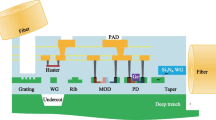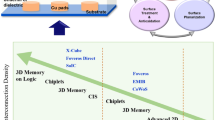Abstract
Network-on-Chip (NoC) has been recognized as the new paradigm to interconnect and organize a high number of cores. NoCs address global communication issues in System-on-Chips (SoC) involving communication-centric design and implementation of scalable communication structures evolving application-specific NoC design as a key challenge to modern SoC design. In this paper we present a SystemC customization framework and methodology for automatic design and evaluation of regular and irregular NoC architectures. The presented framework also supports application-specific optimization techniques such as priority assignment, node clustering and buffer sizing. Experimental results show that generated regular NoC architectures achieve an average of 5.5 % lower communication-cost compared to other regular NoC designs while irregular NoCs proved to achieve on average 4.5×higher throughput and 40 % network delay reduction compared to regular mesh topologies. In addition, employing a buffer sizing algorithm we achieve a reduction in network’s power consumption by an average of 45 % for both regular and irregular NoC design flow.















Similar content being viewed by others
References
Al Faruque MA, Henkel J (2008) Minimizing virtual channel buffer for routers in on-chip communication architectures. In: Proc of DATE. ACM, New York, pp 1238–1243
Al Faruque MA, Krist R, Henkel J (2008) Adam: run-time agent-based distributed application mapping for on-chip communication. In: Proceedings of the 45th annual design automation conference. ACM, New York
Benini L, de Micheli G (2002) Networks on chips: a new SoC. Paradig Comput 35(1):70–78
Bertozzi D, Jalabert A, Murali S, Tamhankar R, Stergiou S, Benini L, De Micheli G (2005) NoC synthesis flow for customized domain specific multiprocessor systems-on-chip. IEEE Trans Parallel Distrib Syst 16(2):113–129
Bitirgen R et al. (2008) Coordinated management of multiple interacting resources in chip multiprocessors: a machine learning approach. In: Proc of MICRO-41, pp 318–329
Bolotin E, Cidon I, Ginosar R, Kolodny A (2004) Qnoc: Qos architecture and design process for network on chip. J Syst Archit 50(2–3):105–128. Special issue on networks on chip
Bononi L, Concer N (2006) Simulation and analysis of network on chip architectures: ring, spidergon and 2d mesh. In: Proc of DATE, pp 154–159
Borkar S (2007) Thousand core chips: a technology perspective. In: Proc of DAC. ACM, New York, pp 746–749
Cao J et al. (2002) Arms: an agent-based resource management system for grid computing. Sci Program 10:135–148
Carara EA, Calazans NLV, Moraes FG (2009) Managing QoS flows at task level in NoC-Based MPSoCs, p 6. http://www.inf.pucrs.br/~calazans/publications/2009_VLSI_SoC_Carara.pdf
Cardoso RS, Kreutz ME, Carro L, Susin AA (2005) Design space exploration on heterogeneous network-on-chip. In: Proc of ISCAS. IEEE Press, New York, pp 428–431
Casavant TL, Kuhl JG (1988) A taxonomy of scheduling in general-purpose distributed computing systems. IEEE Trans Softw Eng 14:141–154
Chaco: Software for Partitioning Graphs. http://www.cs.sandia.gov/~ bahendr/chaco.html
Choudhary N, Gaur M, Laxmi V (2011) Irregular noc simulation framework: irnirgam. In: 2011 international conference on emerging trends in networks and computer communications (ETNCC), pp 1–5
De Micheli G (2009) An outlook on design technologies for future integrated systems. IEEE Trans Comput-Aided Des Integr Circuits Syst 28(6):777
Dick RP et al. (1998) Tgff: task graphs for free. In: CODES’98, pp 97–101
Filippopoulos I, Anagnostopoulos I, Bartzas A, Soudris D, Economakos G (2010) Systematic exploration of energy-efficient application-specific network-on-chip architectures. In: Proc of ISVLSI. IEEE Computer Society, Washington, pp 133–138
Goossens K, Dielissen J, Radulescu A (2005) Æhereal network on chip: concepts, architectures, and implementations. IEEE Des Test Comput 22(5):414–421
Hansson A, Goossens K (2011) A quantitative evaluation of a network on chip design flow for multi-core consumer multimedia applications. Des Autom Embed Syst 15:159–190. doi:10.1007/s10617-011-9073-7
Hendrickson B, Leland R (1995) A multilevel algorithm for partitioning graphs. In: Proc supercomputing, vol 95, p 285
Howard J et al. (2010) A 48-core ia-32 message-passing processor with dvfs in 45 nm cmos. In: Proc of ISSCC, pp 108–109. doi:10.1109/ISSCC.2010.5434077
Hu J, Marculescu R (2004) Application-specific buffer space allocation for networks-on-chip router design. In: Proc of ICCAD. IEEE Computer Society, Washington, pp 354–361
Hu J, Marculescu R (2005) Energy- and performance-aware mapping for regular noc architectures. IEEE Trans Comput-Aided Des Integr Circuits Syst 24(4):551–562
Jantsch A, Tenhunen H (eds) (2003) Networks on chip. Kluwer Academic, Dordrecht
Kobbe S et al. (2011) Distrm: distributed resource management for on-chip many-core systems. In: Proc of CODES+ISSS, pp 119–128
Lai K et al. (2005) Tycoon: an implementation of a distributed, market-based resource allocation system. Multiagent Grid Syst 1:169–182
Lecler JJ, Baillieu G (2011) Application driven network-on-chip architecture exploration & refinement for a complex soc. Des Autom Embed Syst 15:133–158. doi:10.1007/s10617-011-9075-5
Lee HG, Ogras UY, Marculescu R, Chang N (2006) Design space exploration and prototyping for on-chip multimedia applications. In: Proc of DAC. ACM, New York, pp 137–142
Murali S, De Micheli G (2004) Sunmap: a tool for automatic topology selection and generation for nocs. In: Proc of DAC. ACM, New York, pp 914–919
Murali S, Micheli GD (2004) Bandwidth-constrained mapping of cores onto NoC architectures. In: Proc of DATE. IEEE Computer Society, Washington, p 20896
Nesbit K et al. (2008) Multicore resource management. IEEE MICRO 28(3):6–16
Nirgam. online. http://www.nirgam.ecs.soton.ac.uk
Noxim: network-on-chip simulator. http://sourceforge.net/projects/noxim/
Ogras U, Marculescu R (2005) Application-specific network-on-chip architecture customization via long-range link insertion. In: Proc of ICCAD, pp 246–253
Rajkumar R et al. (1997) A resource allocation model for qos management. In: Proc of RTSS, pp 298–307
Seiler L et al. (2008) Larrabee: a many-core x86 architecture for visual computing. ACM Trans Graph 27:18:1–18:15
Semiconductor Industry Association: International technology roadmap for semiconductors (2006). http://www.itrs.net/Links/2006Update/2006UpdateFinal.htm
Shang L, Peh LS, Jha NK (2003) Powerherd: dynamic satisfaction of peak power constraints in interconnection networks. In: Proc of ICS. ACM, New York, pp 98–108
SoCWire. http://socwire.org/
STMicroelectronics (2005) STNoC: building a new system-on-chip paradigm. White Paper
van Berkel CHK (2009) Multi-core for mobile phones. In: Proc of DATE. EDAA, Leuven, pp 1260–1265
Vangal S, Howard J, Ruhl G, Dighe S, Wilson H, Tschanz J, Finan D, Iyer P, Singh A, Jacob T et al. (2007) An 80-tile 1.28 TFLOPS network-on-chip in 65 nm CMOS. In: Proc of ISSCC. IEEE Press, New York, pp 98–589
Ye TT, Benini L, De Micheli G (2003) Packetized on-chip interconnect communication analysis for mpsoc. In: Proceedings of the conference on design, automation and test in Europe, vol 1
Zhang W, Li T (2008) Managing multi-core soft-error reliability through utility-driven cross domain optimization. In: Proc of ASAP
Acknowledgements
The authors would like to thank Dionisios Diamantopoulos (NTUA, Greece) for the help he provided regarding the hardware amount of the routers.
Author information
Authors and Affiliations
Corresponding author
Additional information
The research activities that led to these results, were cofinanced by Hellenic Funds and by the European Regional Development Fund (ERDF) under the Hellenic National Strategic Reference Framework (NSRF) 2007–2013, according to Contract no. MICRO2-E-B/E-II of the Project “Next Generation Millimeter Wave Backhaul Radio” within the Programme “Hellenic Technology Clusters in Microelectronics—Phase-2 Aid Measure”.
This work has been performed when I. Filippopoulos was a member of NTUA.
Rights and permissions
About this article
Cite this article
Anagnostopoulos, I., Bartzas, A., Filippopoulos, I. et al. High-level customization framework for application-specific NoC architectures. Des Autom Embed Syst 16, 339–361 (2012). https://doi.org/10.1007/s10617-013-9114-5
Received:
Accepted:
Published:
Issue Date:
DOI: https://doi.org/10.1007/s10617-013-9114-5




